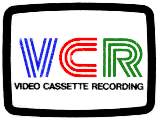 | |
| Media type | Video recording media |
|---|---|
| Encoding | PAL |
| Standard | 625-line |
| Developed by | Philips |
| Usage | Home video, Educational use |
| Released | 1972 |

Video Cassette Recording (VCR) is an early domestic analog recording format designed by Philips. It was the first successful consumer-level home videocassette recorder (VCR) system. Later variants included the VCR-LP and Super Video (SVR) formats.
The VCR format was introduced in 1972, just after the Sony U-matic format in 1971. Although at first glance the two might appear to have been competing formats, they were aimed at very different markets. After failing as a consumer format,[1] U-matic was marketed as a professional television production format, whilst VCR was targeted particularly at educational but also domestic users. Unlike some other early formats such as Cartrivision, the VCR format does record a high-quality video signal without resorting to Skip field.
Home video systems had previously been available, but they were open-reel systems (such as the Sony CV-2000) and were expensive to both buy and operate. They were also unreliable and often only recorded in black and white such as the EIAJ-1. The VCR system was easy to use and recorded in colour but was still expensive: when it was introduced in 1972 the N1500 recorder cost nearly £600 (equivalent to £10,000 in 2023). By comparison, a small car (the Morris Mini) could be purchased for just over £600.

The VCR format used large square cassettes with 2 co-axial reels, one on top of the other, containing 1⁄2-inch-wide (12.7 mm) chrome dioxide magnetic tape. Three playing times were available: 30, 45 and 60 minutes. The 60-minute videocassettes proved very unreliable, suffering numerous snags and breakages due to the very thin 17-micrometre (0.67-mil) video tape. Tapes of 45 minutes or less contained 20-micrometre (0.79-mil) thickness tape. The mechanically complicated recorders themselves also proved somewhat unreliable. One particularly common failing occurred should tape slack develop within the cassette; the tape from the top (takeup) spool may droop into the path of the bottom (supply) spool and become entangled in it if rewind was selected. The cassette would then completely jam and require dismantling to clear the problem, and the tape would then be creased and damaged.
The system predated the development of the slant azimuth technique to prevent crosstalk between adjacent video tracks, so it had to use an unrecorded guard band between tracks. This required the system to run at a tape speed of 14.29 cm/s (5.63 inches per second).[2] 6.56 cm/s (2.58 inches per second) was the speed of the long play variant.[3]
The Philips VCR system brought together many advances in video recording technology to produce the first truly practical home video cassette system. The very first Philips N1500 model included all the essential elements of a domestic video cassette recorder:
- Simple loading of cassette and simple operation using "Piano Key" controls, with full auto-stop at tape ends.
- A tuner for recording off-air television programmes.
- A clock with timer for unattended recordings.
- A modulator to allow connection to a normal (for the time) television receiver without audio and video input connectors.
The Philips VCR system was marketed only in the UK, mainland Europe, Australia and South Africa. In mid-1977, Philips announced they were considering distribution of the format in North America, and it was test marketed for several months. Because the format was initially designed only for use with the 625-line 50-hertz (3,000 rpm) PAL system, VCR units had to be modified in order to work with the 60-hertz (3,600 rpm) NTSC system. Unfortunately, for mechanical and electronic reasons, the tape speed had to be increased by 20%, which resulted in a 60-minute PAL tape running for 50 minutes in a NTSC machine. DuPont announced a thinner videotape formulation that would allow a 60-minute NTSC VCR tape (and roughly 70 minutes in PAL), but the tape was even less reliable than previous formulations. Ultimately, Philips abandoned any hope of trying to sell their VCR format in North America, partly because of the reliability issues, and partly because of the introduction of VHS that same year.
- ^ Ascher, Steven; Pincus, Edward (2007). The Filmmaker's Handbook: A Comprehensive Guide for the Digital Age. New York: Penguin Group US. ISBN 978-1-4406-3700-1. Archived from the original on 15 April 2023. Retrieved 8 September 2016 – via Google Books.
- ^ "N 1500 Video Recorder Service Manual" (Manual) (in Dutch). Philips. p. 16. Retrieved 13 June 2024 – via Internet Archive.
- ^ "N1700 video cassetterecorder Service Manual" (Manual). Philips. p. 4. Retrieved 13 June 2024 – via Internet Archive.